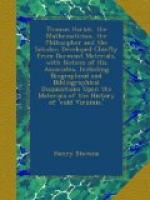And had I but known of any precedent, (as since in Harriot I find one, and I think but one √_-dddddd,)_ I should not have scrupled to follow it; but I was then too young an algebraist to innovate without example. Since that time I have been more venturous, and I find now that others do not scruple to use it as well as I. [Just what Descartes did. He ’ innovated’ prior to 1637, when he took Hariot’s well recognized notation in algebra to work out his problems in geometry for which Hariot himself would have thanked him.]
Wallis to Collins, May 6, 1673, vol. ii, page 578.
One Torporley, long since, left a manuscript treatise in Latin in Sion College, wherein is a much more copious table of figurate numbers, which I have caused to be transcribed, with what he says de combinationibus, to send to Mr. Strode.
On this passage, extracted from a letter from Collins to Baker, dated the 19th of August, 1676, Professor Rigaud has the following note, written in 1841, vol. ii, page 5 :
Nath. Torporley left his manuscripts to Sion College, where he spent the latter years of his life ; but the greater part of them was destroyed by the fire of London. Reading, in his catalogue of the library, mentions only one, " Corrector Analyticus,” which is an attack on Warner for the manner in which he had edited Harriot’s " Artis Analyticæ Praxis.” This is a short tract, and incomplete. There is, however, another volume, A. 37-39, entitled, “Algebraica, Tabulæ Sinuum,&c.” in which Torporley’s hand may be certainly recognized. Wood, in the list of his works, speaks of “Congestor opus Mathematicam,- imperfect.” A perfect copy of this treatise is in Lord Maccles-field’s possession, and probably once belonged to Collins.
Perhaps the best comment that one can make on the wild and extraordinary statements contained in the above extracts is to ask the reader to read over Hariot’s Will,given entire on pages 193-203, and especially this Item respecting his Mathematical and other Writings, and the Rev. Nathaniel Torporley, from which it will appear that all his valued papers were bequeathed with great care to the Earl of Northumberland, to be deposited in his library in a trunk with lock and key, after they had been looked over and perused, by Mr Torporley, and (the waste papers having been weeded out) the whole arranged by him ’ to the end that after hee doth vnderstand them he may make use in penning such doctrine that belongs unto them for publique use.’ This, of course, was to be done under the supervision of the four Executors, who were persons of no less distinction than Sir Robert Sidney Knight Viscount Lisle, John Protheroe Esquire, Thomas Aylesbury Esquire, and Thomas Buckner Mercer.




